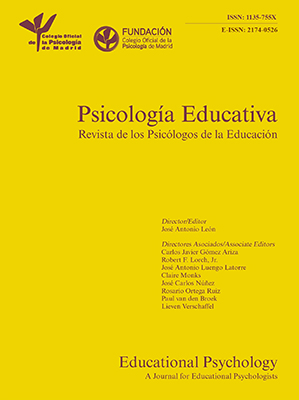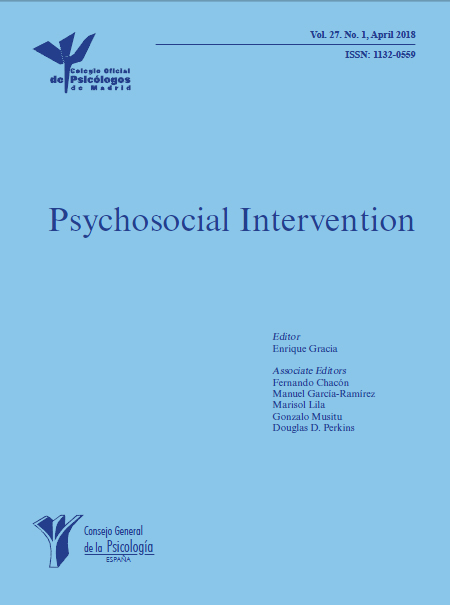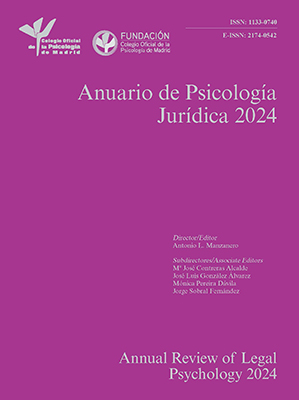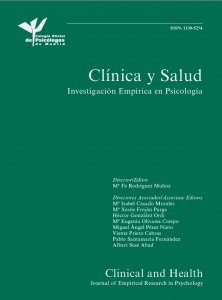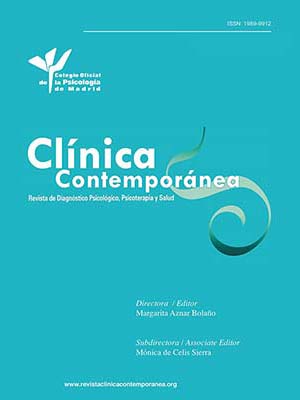
Personal Strategies on the Dynamics of Job Demands-Resources and Fatigue: A Latent Transition Approach
[Las estrategias personales en las dinámicas de demandas-recursos del trabajo y la fatiga: un enfoque de transiciones latentes]
Manuel Pulido-Martos, Esther López-Zafra, & Daniel Cortés-Denia
Universidad de Jaén, Spain
https://doi.org/10.5093/jwop2025a8
Received 24 April 2025, Accepted 9 July 2025
Abstract
Fatigue can lead to negative workplace consequences. Within a job demands-resources framework, this study examines: (a) latent profiles of job demands and job and personal resources, (b) associated fatigue levels, (c) profile stability over time, and (d) how job-crafting and self-undermining influence profile membership and transitions, impacting fatigue. Data was collected from Spanish employees at two time points (T1, n = 749; T2, n = 228) and analyzed using latent profile and latent transition approaches. Results revealed three stable profiles: (1) limited leadership resources and moderate workload, (2) moderate resources and moderate workload, and (3) high resources and moderate-high workload, with the latter showing lowest fatigue levels. Job-crafting predicted both maintenance of favorable profiles and transitions toward high-resource profiles. Self-undermining showed no significant effects. Findings highlight job crafting’s importance in maintaining beneficial resource-demand profiles that prevent workplace fatigue, suggesting organizations should promote job-crafting behaviors as effective fatigue management strategies.
Resumen
La fatiga puede acarrear consecuencias negativas en el lugar de trabajo. En el marco teórico de las demandas-recursos laborales, este estudio analiza: (a) los perfiles latentes de las demandas laborales y los recursos laborales y personales, (b) el grado de fatiga asociada, (c) la estabilidad de los perfiles a lo largo del tiempo y (d) cómo influyen el desarrollo propio de destrezas y el autosocavamiento en la pertenencia a perfiles y en las transiciones y cómo afectan a la fatiga. Se recogieron los datos de personas empleadas en España en dos momentos (T1, n = 749; T2, n = 228) y se analizaron utilizando análisis de perfiles y transiciones latentes. Los resultados identificaron tres perfiles estables: (1) recursos limitados de liderazgo y carga de trabajo moderada, (2) recursos moderados y carga de trabajo moderada y (3) recursos elevados y carga de trabajo moderada-alta, siendo estos últimos los que tenían un nivel menor de fatiga. El desarrollo propio de destrezas explicaba tanto el mantenimiento de perfiles favorables como las transiciones hacia perfiles de recursos elevados. El autosocavamiento no mostró efectos significativos. Los resultados subrayan la importancia del desarrollo propio de destrezas en la pertenencia a perfiles favorables de recursos-demandas que previenen la fatiga laboral, lo que indica que las empresas deberían fomentar el desarrollo propio de destrezas como una estrategia eficaz de gestión de la fatiga.
Palabras clave
Fatiga, TeorĂa de las demandas-recursos del trabajo, Liderazgo, Estrategias personales, Carga de trabajoKeywords
Fatigue, Job demands-resources theory, Leadership, Personal strategies, WorkloadCite this article as: Pulido-Martos, M., López-Zafra, E., & Cortés-Denia, D. (2025). Personal Strategies on the Dynamics of Job Demands-Resources and Fatigue: A Latent Transition Approach. Journal of Work and Organizational Psychology, 41(2), 75 - 83. https://doi.org/10.5093/jwop2025a8
Correspondence: mpulido@ujaen.es (M. Pulido-Martos).The latest overview report of the European Working Conditions Survey (Eurofound, 2017) suggests that 35% of European Union workers suffer from work-related fatigue, and research shows high prevalence rates in specific occupations such as nursing and information technology technicians (Younan et al. 2019; Zheng et al., 2023). Therefore, it is considered a relevant variable in the work context. Fatigue is a multidimensional construct (Winwood et al., 2005) defined by a reduction in the functional capacity of physical, mental, and emotional resources, with an intense feeling of exhaustion, which is experienced both during and at the end of the workday (Frone & Tidwell, 2015). Research across workplaces demonstrates that different types of fatigue (from acute fatigue to chronic fatigue; Winwood et al., 2005) can lead to significant consequences, including decreased performance (Jalali et al., 2023), increased risk of injuries (Cunningham et al., 2022), and adverse health outcomes (Knoop et al., 2021). Several studies have found that fatigue results from job demands (Garrick et al., 2014; Rietze & Zacher, 2022). According to the job demands-resources theory (JD-R; Bakker & Demerouti, 2017), job demands are physical, social, and organizational aspects of the job requiring effort or skills involving psychological and/or physiological costs to the employee, harming their health or leading to burnout. Job demands (e.g., workload, work pressure, or emotional demands) are the main predictor of the exhaustion component of burnout (Bakker et al., 2004), with workload being a fundamental aspect of these demands. Specifically, fatigue is an outcome of effort expenditure related to workload (Cho et al., 2022; Rietze & Zacher, 2022), which in the domain of occupational stress is equated with job demand (MacDonald, 2003). In addition, the JD-R theory (Bakker & Demerouti, 2017) also considers that employees possessing sufficient personal and/or job resources may encounter high demands not experiencing high levels of fatigue, stress, or exhaustion (e.g., Cao et al., 2020; Cho et al., 2022; Rietze & Zacher, 2022). From this framework, job and/or personal resources should be considered alongside demands to understand fatigue development. In the case of personal resources, such as psychological capital (PsyCap), they allow dealing with the situation more effectively (Grover et al., 2018). PsyCap refers to the collection of personal psychological resources that encompass positive psychological states, such as hope, resilience, self-efficacy, and optimism, playing a crucial role in shaping an individual’s attitudes, behaviours, and performance (Luthans et al., 2015). PsyCap has shown a negative association with fatigue and mediates the association between job stress and fatigue (Tian et al., 2020), while a job resource, such as adequate leadership, can interact with workload to help prevent and mitigate worker fatigue, through adequate supervision, balancing, and distribution of workloads (Cho et al., 2022). Indeed, a transformational leader (TFL) develops an environment where employees are motivated and energized and helps them reach goals with high standards (Antonakis et al., 2003). This TFL can result in fewer job demands and more job resources (Fernet et al., 2015), also reducing emotional exhaustion and burnout (Hildenbrand et al., 2018). However, while most research uses a variable-centered approach, they ignore the potential profiles of employees with different levels of personal demands and work resources and lack a longitudinal perspective. In this vein, considering a person-centered approach would allow the examination of the combination and management of more than two variables (TFL, workload, and PsyCap in this study) that could be difficult to address through the traditional variable-centered approach (Morin et al., 2020), identifying profiles of workers through patterns of variables and comparing them with other identified profiles (Spurk et al., 2020). From a person-centered approach, and considering the JD-R theory (Bakker & Demerouti, 2017), several studies have focused on identifying these demand-resource profiles and their relationship with other outcomes related to well-being, job satisfaction, or a set of work capabilities. In this regard, Cortés-Denia et al. (2024) found that TFL determined the probability of pertaining to a more positive profile and, therefore, to higher workers’ health. Furthermore, Lee and Cho (2020) identified four profiles differentiated by the job and personal resources (i.e., co-worker and supervisor support, self-esteem, optimism, and active coping), but no differences were found in job demands among the profiles, which differ from other studies (Barnard et al., 2023; Marzocchi et al., 2023; Pulido-Martos et al., 2023). Particularly, Marzocchi et al. (2023) found combinations of different demands (i.e., workload, emotional dissonance, and patient and physical demands) and resources (i.e., management and peers’ support, and control). These combinations yielded four identified profiles on worker satisfaction, whereas the profiles (about job demands of challenge, emotional and hindrance, and several resources) identified by Barnard et al. (2023) were related to a work capability set (i.e., using and developing knowledge and skills, setting own goals). In this vein, Pulido-Martos et al. (2023) found that personal resources (emotional intelligence, vigor, and self-efficacy) and demands (effort at work and overcommitment) were related to well-being, but the number of profiles increased to five. Despite attempts to identify profiles and the variability of demands and resources addressed, to date no studies have proved the implications of the demands-resources on fatigue from a person-centered approach. Additionally, two self-reinforcing personal strategies are included in the original theory that may change the perception of JD-R, potentially modifying transitions or changes in the levels of the variables and, consequently, affecting changes in the profiles over time. Particularly, job-crafting refers to a proactive change in demands and resources (Tims & Bakker 2010), which produces a spiral of profits increasing the motivational aspect. Moreover, the job-crafting strategies have been positively related to team PsyCap (Uen et al., 2021) and daily leader’s transformational behaviour (Hetland et al., 2018) and negative in cross-sectional and longitudinal to exhaustion and fatigue (Pijpker et al., 2022). The second strategy, but in this case of maladaptive self-regulation, is self-undermining or self-sabotage, that refers to provoking performance-boycotting obstacles (Bakker & Costa, 2014), producing a spiral of losses and health impairment. It is negatively related to job performance and positively to burnout. Self-undermining has mediated the relationship between job demands and burnout (Zeshan et al., 2024). Considering all of the above, the stability and/or transition of an individual’s profile membership over time, including antecedent personal strategies such as job crafting or self-undermining, has not been examined. Thus, the impact of personal strategies (job-crafting and self-undermining) on a demands-resources profile membership and temporal transitions between profiles and their subsequent effects on fatigue remain unexplored. Therefore, this study aims to examine: (a) distinct latent profiles of job demands (workload), job resources (TFL), and personal resources (PsyCap); (b) fatigue levels associated with each profile; (c) the stability of the profiles over time; and (d) the role of personal strategies (job-crafting and self-undermining) in profile membership probability and transitions. Participants The data was collected on a heterogeneous sample of Spanish employees, at two-time points with a 3-month transition period between measurements. In T1, 1.45% of the initial respondents were excluded due to outliers or missing responses. Thus, the final sample was composed of 749 employees (54.2% females) with a mean age of 41.27 (SD = 11.92) and an average tenure at the organization of 11.33 years (SD = 10.63). Considering the type of organization in which the participants were employed, 59.7% of the employees worked in private organizations, 35.1% in public organizations, and 5.2% in mixed organizations. From T1, to be included in T2, workers had to maintain at the same organization and have the same leader. A total of 228 employees (50.9% females) participated in T2. They had a mean age of 43.15 (SD = 11.45) and an average tenure at the organization of 12.31 years (SD = 10.72). The participants in T2, worked in private (59.7%,), public (34.2%), and mixed organizations (6.1%). Instruments Transformational leadership was measured using the TFL dimension from the shortened version of the Multifactor Leadership Questionnaire (MLQ-S; López-Zafra, 1998). In this study, the 10 items assessing the TFL style perceived by employees from their supervisors were used. The response format was a 5-point Likert scale (from 0 = never to 4 = almost always). The global score showed a Cronbach’s alpha = .95 in T1 and .96 in T2. Psychological capital was measured using the shortened version of the Psychological Capital Questionnaire (PCQ; León-Pérez et al., 2017). This questionnaire contains 12 items with a 6-point Likert response format (from 1 = never to 6 = always). In this study, we used the total score, with a Cronbach’s alpha of .87 in T1 and .90 in T2. Workload was assessed using the 6-items from the psychological demands subscale from the Job Content Questionnaire (JCQ; Karasek et al., 1998) with a 4-point Likert response format (from 1 = strongly disagree to 4 = strongly agree). Cronbach’s alpha was .64 in T1 and .62 in T2. Occupational fatigue was measured using the Swedish Occupational Fatigue Inventory (SOFI; Ahsberg et al., 1997). It is composed of 15 items with an 11-point Likert response format (from 0 = not at all to 10 = very high). Cronbach’s alpha was .92 in T1 and T2. Job-crafting was measured using the short version of the Job Crafting Scale (JCS; Sora et al., 2018). This scale contains 12 items with a 7-point Likert response format (from 1 = never to 7 = always). Cronbach’s alpha was .74 in T1, and .78 in T2. Self-undermining was measured using the Self-Undermining Scale (Bakker & Wang, 2020). This scale contains 6 items with a 7-point Likert response format (from 1 = never to 7 = very often). Cronbach’s alpha was .76 in T1 and .73 in T2. Procedure Full-time employees with direct supervisors were recruited through university students using incidental sampling. Previously, the students were instructed on the procedure and distribution of the survey. After providing informed consent, participants completed a baseline and 3-month follow-up questionnaires (between October 2023 and January 2024). Regarding the administration of the measures, they were presented in the following order in both periods: (1) workload, (2) occupational fatigue, (3) job-crafting, (4) self-undermining, (5) PsyCap, and (6) TFL. The Ethics Committee of the University of Jaén approved the study (Ref. DIC.20/8.PRY). Data Analyses Statistical analyses were conducted using Mplus 8.4. First, latent profile analysis (LPA) identified distinct patterns at both time points (T1 and T2) using factor scores from psychological demands, TFL, and PsyCap measures. To determine the optimal number of profiles, we examined multiple fit indices and statistical tests. We evaluated the Akaike information criterion (AIC), consistent AIC (CAIC), Bayesian information criterion (BIC), and sample-size adjusted BIC (SSA-BIC), where lower values indicate better fit (Nylund et al., 2007). The approximate weight of evidence criterion (AWE) was also considered, with lower values suggesting better solutions. We assessed the statistical significance of including an additional profile using the bootstrap likelihood ratio test (BLRT) and Vuong-Lo-Mendell-Rubin likelihood ratio test (VLMR-LRT), where p-values < .05 indicate that the k-profile model fits significantly better than the k-1 profile model. Classification quality was evaluated using entropy values (range: 0-1), with values above .80 indicating good classification accuracy. Additionally, we examined the Bayes factor (BF), where values > 10 provide strong evidence for favouring the more complex model and created elbow plots to visualize the improvement in fit indices across solutions. The final profile solution was selected based on the convergence of these indicators, theoretical interpretability, and profile sizes sufficient for meaningful interpretation (profiles containing at least 8% of the sample). To assess measurement invariance across time points, we conducted two latent transition analyses (LTA; Collins & Lanza, 2010): one with invariance constraints and another without such constraints. We compared these models using the log-likelihood ratio test (LRT) with the Satorra-Bentler adjustment. Additionally, we considered the BIC and SSA-BIC indices to achieve a balance between fit and parsimony. Subsequently, we examined transition probabilities between profiles from T1 to T2 following procedures outlined by Morin and Litalien (2017). To investigate potential predictors of profile membership, we included job crafting and self-undermining levels at T1 as predictors of initial profile membership, while changes in these variables from T1 to T2 were included as predictors of profile membership at T2. Finally, we conducted within-time comparisons of profiles on fatigue levels using pairwise comparisons and examined temporal changes in fatigue through a Wald test of mean differences across time points. Given that only 228 participated at T2, from the 749 at T1, we used full information maximum likelihood estimation (FIML) combined with a robust maximum likelihood estimator (MLR) in Mplus to handle missing data (Enders, 2010). Table 1 presents the means, standard deviations, and inter-correlations of the main study variables at both time points. Table 1 Means, Standard Deviations, and Correlations   Note. T1 = Time 1; T2 = Time 2; TFL = transformational leadership; PC = psychological capital; JC = job-crafting; SU = self-undermining. *p < .05, **p < .01, ***p < .001. The results from the LPA are presented in Table 2. Considering the combination of different indices, such as the significant p-value for VLMR-LRT and in T2 a lower BIC value, we decided to retain the three-profile solution for both time points. Table 2 Fit Indices and Number of Profiles for Time 1 and Time 2  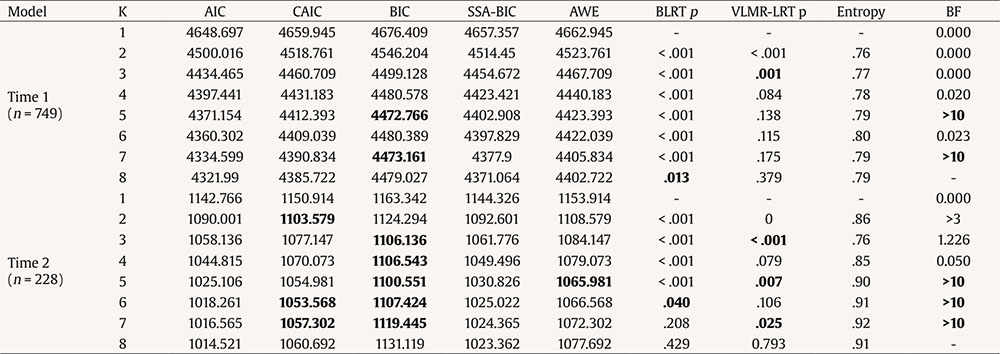 Note. K = number of profiles; AIC = Akaike information criterion; CAIC = consistent Akaike information criterion; BIC = Bayesian information criterion; SSA-BIC = sample-size adjusted Bayesian information criterion; AWE = approximate weight of evidence; BLRT = bootstrap likelihood ratio test; VLMR-LRT = Vuong-Lo-Mendell-Rubin likelihood ratio test; BF = Bayes factor. For T1, the classes with 5 and 7 profiles could be considered adequate, and the same applies to T2 with the classes with 5, 6, and 7 profiles. However, considering the relative sizes of the emergent classes and the need to ensure stability, we opted to retain the three-profile solution for T1 and T2, ensuring a relatively large size (14.20% and 17.50%, respectively). Additionally, the Elbow plot (Figure 1) demonstrated that the slopes levelled off around the three-profile solution. Figure 1 Elbow Plot for AIC, CAIC, BIC and SSA-BIC in Determining Profile Solution.   Note. AIC = Akaike information criteria; CAIC = consistent Akaike information criterion; BIC = Bayesian information criterion; SSA-BIC = sample-size adjusted Bayesian information criterion. To depict the retained profiles, Figure 2 (left) shows the three profiles for T1 and also for T2 (right), reflecting their similarity. To name the profiles, we compared them in terms of the mean scores of the indicators. Table 3 shows the mean differences and p-values for T1 and T2. The results indicate that Profile 1 has lower levels of perceived TFL compared to Profile 2 and Profile 3. Similarly, Profile 2 has lower levels of perceived TFL than Profile 3. These differences are consistent across T1 and T2. Regarding workload, there are no statistically significant differences between profiles at T1. However, at T2, Profile 1 has lower workload levels than Profile 3, and the same applies to Profile 2 compared to Profile 3. For PsyCap, the same pattern is observed at both T1 and T2. Profile 1 significantly differs from Profile 3, and Profile 2 significantly differs from Profile 3, with no significant differences between Profile 1 and Profile 2. Based on these differences, we labelled the profiles as Limited Leadership Resources and Moderate Workload (Profile 1), Moderate Resources and Moderate Workload (Profile 2), and High Resources and Moderate-High Workload (Profile 3). We assessed measurement invariance. The LRT result was 24.75 (p < .05). An examination of the BIC and SSA-BIC indices indicated that the measurement invariance model provided a better fit to the data compared to the non-invariance model (BIC: 5480.50 vs. 5512.12; SSA-BIC: 5407.46 vs. 5410.50, respectively). Based on these results, full measurement invariance was supported and implemented in subsequent analytical procedures. Figure 3 displays the transition probabilities and prevalence at T2 conditioned by T1. Transitions from profiles estimated at T1 were mostly retained at T2. Beyond near-zero probabilities, the probability of transitioning from Moderate Resources and Moderate Workload at T1 to Limited Leadership Resources and Moderate Workload at T2 is .11, and from Limited Leadership Resources and Moderate Workload at T1 to High Resources and Moderate-High Workload at T2 is .10. The probability of transitioning from High Resources and Moderate-High Workload at T1 to Moderate Resources and Moderate Workload at T2 is slightly higher at .23. Figure 3 Transition Pathways and Their Prevalence.  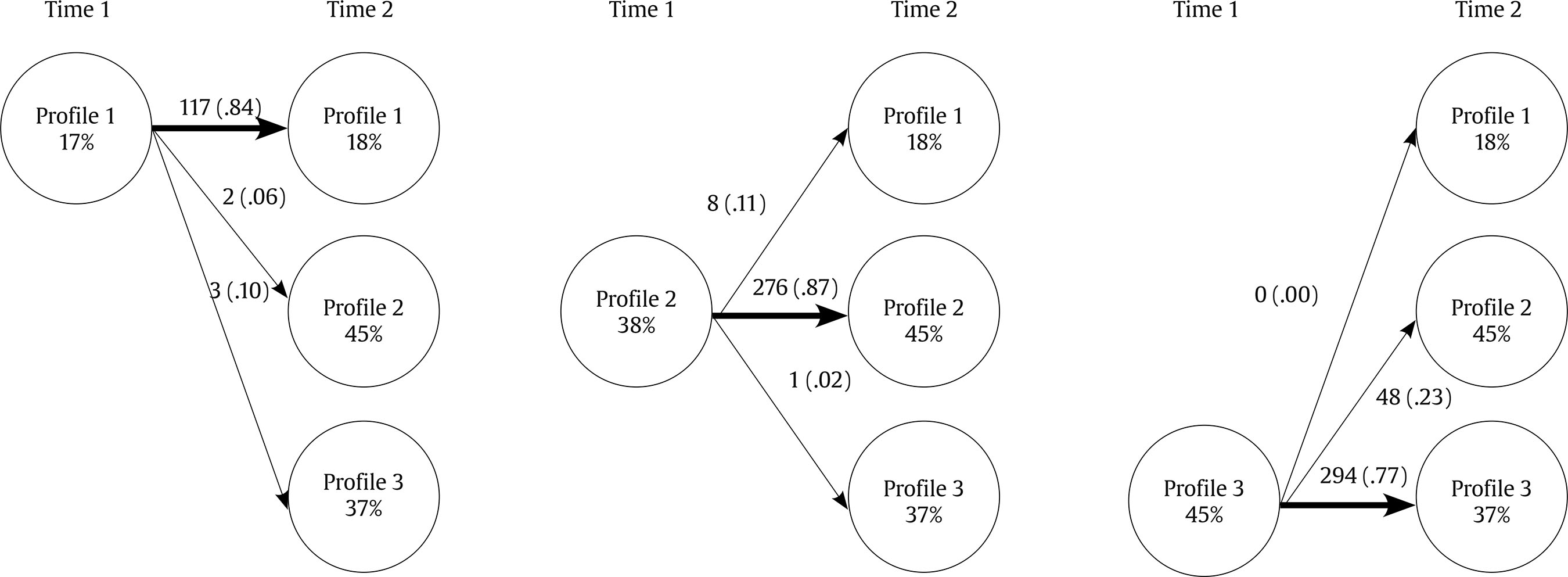 Note. The thickness of the lines represents the prevalence of transitions; the values (numbers within the small boxes) denote the count of individuals transitioning between profiles from T1 to T2, and the transition probabilities are shown in parentheses. A final set of models included job crafting and self-undermining levels at T1 as predictors of profile membership at T1. Changes in job crafting and self-undermining from T1 to T2 were included as predictors of profile membership at T2. This analysis aimed to determine if changes in job crafting and self-undermining could predict profile membership at T2 beyond the prediction from T1 profile membership (see Table 4). Job crafting at T1 negatively predicted membership in Profiles 1 (Limited Leadership Resources and Moderate Workload) and 2 (Moderate Resources and Moderate Workload) regarding the reference profile (Profile 3: High Resources and Moderate-High Workload). The odds ratios indicated that job crafting reduced the likelihood of membership in Profiles 1 (Limited Leadership Resources and Moderate Workload) and 2 (Moderate Resources and Moderate Workload) compared to Profile 3 (High Resources and Moderate-High Workload). Thus, increased job crafting perceptions enhanced the likelihood of remaining in a favourable profile as High Resources and Moderate-High Workload. On the contrary, self-undermining levels at T1 did not affect profile membership probabilities at T1 (Table 4). Given the profiles’ stability, changes in job crafting did not predict T2 profile membership likelihood, and when it did, it was in a different direction than at T1. For the High Resources and Moderate-High Workload profile, the likelihood of changing to Profile 2 (Moderate Resources and Moderate Workload) increased with higher job crafting levels. Again, self-undermining levels at T2 did not influence profile membership probabilities at T2. Table 4 Job Crafting and Self-undermining Predicting in Latent Transition Analyses   Note. SE = standard error; OR = odds ratio. *p < .05, **p < .01. These findings can be attributed to the profiles’ high stability over time and the accurate classification of employees into these profiles (illustrated by the .76 entropy indicator). Note that a small percentage of the sample switched profiles from T1 to T2. The largest transition involved 48 employees moving from the High Resources and Moderate-High Workload profile at Time 1 to the Moderate Resources and Moderate Workload profile at T2, explaining why this transition was the only one predicted by changes in job crafting. Table 5 Within-time Comparisons of Profiles on Fatigue   Note. 1Means with similar superscripts within each time point are not significantly different from one another; all of the other means are significantly different from one another. M = mean; SD = standard deviation. ***p < .001. Within-time comparisons of profiles on fatigue are provided in Table 5, showing the mean levels of employee fatigue across the latent profiles at each time point. Almost all pairwise comparisons showed significant mean differences, except for the fatigue levels between Profile 1 (Limited Leadership Resources and Moderate Workload) and Profile 2 (Moderate Resources and Moderate Workload) at T2. At T1, the lowest fatigue levels were found in Profile 3 (High Resources and Moderate-High Workload), followed by Profile 1 (Limited Leadership Resources and Moderate Workload), with the highest fatigue levels in Profile 2 (Moderate Resources and Moderate Workload). At T2, Profile 3 (High Resources and Moderate-High Workload) showed significant differences in fatigue levels compared to Profiles 2 (Moderate Resources and Moderate Workload) and 1 (Limited Leadership Resources and Moderate Workload), with no significant differences between the last two. A Wald test of mean differences across time points confirmed significant differences (χ² = 9.91, df = 3, p < .05). Figure 4 shows a detailed examination of mean differences in fatigue between T1 and T2. From a temporal perspective, our findings suggest that remaining in a favourable profile was related to persistently higher levels of fatigue. Transitions from Profile 3 (High Resources and Moderate-High Workload) to Profile 1 (Limited Leadership Resources and Moderate Workload) or Profile 2 (Moderate Resources and Moderate Workload) led to increased levels of fatigue, as did transitions from Profile 1 (Limited Leadership Resources and Moderate Workload) to Profile 2 (Moderate Resources and Moderate Workload). By adopting a person-centered approach, some studies have revealed several combinations of variables yielding different profiles. Nevertheless, most research has ignored the potential profiles of employees with different levels of personal demands and work-resources, lacking a longitudinal perspective. This study examined distinct profiles of work characteristics and their stability over time. We identified three stable profiles: Limited Leadership Resources and Moderate Workload (Profile 1), Moderate Resources and Moderate Workload (Profile 2), and High Resources and Moderate-High Workload (Profile 3). The profiles demonstrated considerable stability over time, with most employees remaining in their original profiles between T1 and T2. Additionally, we found significant relationships between profile membership and fatigue levels, with the most favourable fatigue outcomes associated with the High Resources and Moderate-High Workload profile. These findings align with previous person-centered research in occupational health psychology that identified distinct configurations of job characteristics (e.g., Cortés-Denia et al., 2024; Pulido-Martos et al., 2023). The emergence of three distinct profiles provides insight into how work characteristics cluster together within organizations. Profile 3 (High Resources and Moderate-High Workload) represents a potentially "healthy" work configuration where employees experience high levels of TFL and PsyCap, albeit moderate-high workloads. This is consistent with the "challenging jobs", conceptualized in recent expansions of the JD-R theory (Bakker & Demerouti, 2017), which can be perceived as rewarding work experiences by promoting personal growth and worker achievement. In contrast, Profile 2 (Moderate Resources and Moderate Workload) appears to represent a more vulnerable configuration, characterized by limited resources despite only moderate demands, similar to the "high strain" profiles identified in previous research (Van den Broeck et al., 2012). Profile 1 (Limited Leadership Resources and Moderate Workload) presents an interesting intermediate case where leadership resources are specifically limited, highlighting the differentiated role of leadership as a job resource (Tummers & Bakker, 2021). The high stability of profiles between T1 and T2 (as evidenced by the entropy value of .76) suggests that work characteristic configurations tend to be relatively enduring over time. This stability aligns with findings from previous longitudinal person-centered studies (Feldt et al., 2013; Urbanaviciute et al., 2021) and may reflect organizational structures and cultures that maintain consistent patterns of resources and demands (Schneider et al., 2013). However, the observed transitions, particularly the change of 48 employees from Profile 3 (High Resources and Moderate-High Workload) to Profile 2 (Moderate Resources and Moderate Workload), warrant attention. This transition from a resource-rich to a resource moderate profile may represent a meaningful deterioration in work conditions for these individuals, which has been related to increased strain and reduced well-being (Cortés-Denia et al., 2024). Our findings regarding job crafting present a nuanced picture. At T1, job crafting negatively predicted membership in the less favourable profiles (Profiles 1 and 2, Limited Leadership Resources and Moderate Workload and Moderate Resources and Moderate Workload, respectively) compared to the resource-rich Profile 3 (High Resources and Moderate-High Workload), suggesting that proactive behaviours may help employees secure better working conditions, consistent with previous research (Pijpker et al., 2022). However, the relationship between changes in job crafting and profile transitions produced some unexpected results, with increased job crafting associated with transitions from Profile 3 (High Resources and Moderate-High Workload) to Profile 2 (Moderate Resources and Moderate Workload). This counterintuitive finding might also suggest that job crafting efforts can sometimes be unsuccessful or that not all the components of job crafting are associated with achieving positive outcomes (Li et al., 2022; Rudolph et al., 2017). However, another explanation could be that employees’ proactive use of job crafting might modify and adapt their work tasks, making them more meaningful (Bakker & Demerouti, 2017), thereby reducing both the influence and perception of their supervisor’s TFL and workload, which could, in turn, impact profile membership. The absence of significant effects for self-undermining on profile membership or transitions contrasts with previous research by Bakker and Wang (2020) and warrants further investigation. It may suggest that self-undermining behaviours operate through different mechanisms than those captured in our profile indicators, or that their effects may be more proximal and immediate rather than sustained over longer time periods (Bakker & Costa, 2014). Finally, the differential associations between profile membership and fatigue levels provide compelling evidence for the health implications of work characteristic configurations. At T1, Profile 3 (High Resources and Moderate-High Workload) members’ reported the lowest fatigue levels, Profile 1 (Limited Leadership Resources and Moderate Workload) reported intermediate levels, and Profile 2 (Moderate Resources and Moderate Workload) reported the highest levels. This pattern partially aligns with the JD-R theory (Bakker & Demerouti, 2017). From a temporal perspective, remaining in the resource-rich Profile 3 (High Resources and Moderate-High Workload) was associated with consistently lower fatigue levels, while transitions to less favourable profiles were associated with increased fatigue. Thus, maintaining moderately high resources (Profile 3) improves well-being, with lower levels of fatigue, compared to having medium or low resources (Profiles 1 and 2). Nevertheless, the variation and differentiation in fatigue levels reported across Profile 1 (Limited Leadership Resources and Moderate Workload) and 2 (Moderate Resources and Moderate Workload) entails limited resources and implies that leadership resources have complex relationships with employee well-being (Inceoglu et al., 2018; Nielsen et al., 2017). This finding underscores the importance of maintaining favourable work conditions over time for sustainable employee well-being, consistent with longitudinal studies of the JD-R model (Lesener et al., 2019). Implications for the Theory and Practice The results extend the JD-R theory by demonstrating how resources and demands naturally cluster within organizations, promoting distinct profiles with meaningful implications for employee outcomes (Bakker & Demerouti, 2017). The identification of a profile specifically characterized by limited leadership resources (Profile 1) suggests that leadership may function as a distinct type of resource, separate from other psychological resources like PsyCap, supporting research on the unique role of leadership in the JD-R model (Tummers & Bakker, 2021). Furthermore, our longitudinal findings regarding profile stability and transitions provide insights into the dynamic nature of the JD-R model over time (Lesener et al., 2019). The generally high stability of profiles challenges assumptions about the malleability of work characteristics and suggests that organizational interventions may need to be substantial to shift employees between profiles, aligning with research on the challenges of organizational change (Petrou et al., 2018). From a practical standpoint, organizations should strive to create and maintain work environments that resemble Profile 3, characterized by high resources even in the face of moderate-high workloads. The transition patterns observed suggest that maintaining favourable profiles is easier than improving unfavourable ones, highlighting the importance of prevention-focused approaches to workplace well-being. Additionally, the complex findings regarding job crafting suggest that organizations should provide structured support for employee job crafting efforts, rather than simply encouraging these behaviours without adequate guidance or resources (Petrou et al., 2018; Thun & Bakker, 2018). This aligns with integrated approaches to job design that combine top-down and bottom-up processes (Grant & Parker, 2009). Limitations of the Study and Future Research Despite its strengths, this study has several limitations. First, the reliance on self-report measures may introduce common method bias. Future research could incorporate objective measures of workload or supervisor ratings of employee behaviours. Second, albeit our two-wave design allowed for the examination of transitions, more frequent measurement points would provide greater insight into the temporal dynamics of profile shifts. Future research should examine additional antecedents and consequences of profile membership and transitions, particularly focusing on organizational factors that might facilitate or hinder moves between profiles (Bakker & Demerouti, 2017). Additionally, investigating whether interventions can effectively shift employees from less favourable to more favourable profiles represents an important avenue for future work. In conclusion, results emphasize job crafting’s role in maintaining beneficial resource-demand profiles for fatigue prevention. Job crafting interventions can be a valuable solution for organizational practitioners by enabling resource generation and reducing fatigue levels. Conflict of Interest The authors of this article declare no conflict of interest. Cite this article as: Pulido-Martos, M., López-Zafra, E., & Cortés-Denia, D. (2025). Personal strategies on the dynamics of job demands-resources and fatigue: A latent transition approach. Journal of Work and Organizational Psychology, 41(2), 75-83. https://doi.org/10.5093/jwop2025a8 Funding This research was supported by the Spanish Ministry of Science and Innovation under project PID2020-116521RB-I00, funded by MCIN/AEI/10.13039/501100011033. References |
Cite this article as: Pulido-Martos, M., López-Zafra, E., & Cortés-Denia, D. (2025). Personal Strategies on the Dynamics of Job Demands-Resources and Fatigue: A Latent Transition Approach. Journal of Work and Organizational Psychology, 41(2), 75 - 83. https://doi.org/10.5093/jwop2025a8
Correspondence: mpulido@ujaen.es (M. Pulido-Martos).Copyright © 2025. Colegio Oficial de la Psicología de Madrid











 e-PUB
e-PUB CrossRef
CrossRef JATS
JATS
